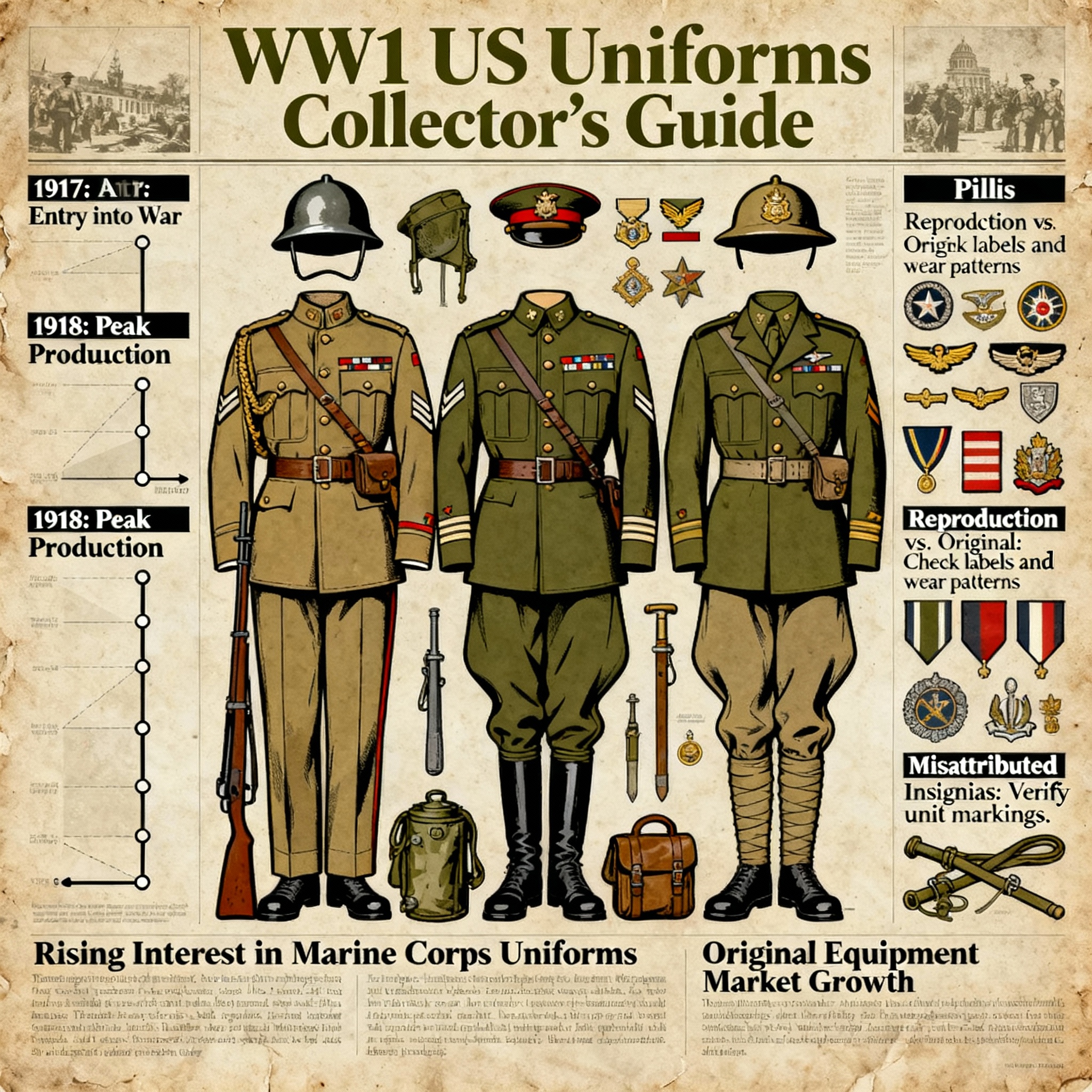
WW1 United States Uniforms: A Collector’s Guide to History, Pitfalls & Trends
Published on Oct 04, 2025
Introduction: Did You Know WW1 Changed the Look of the Modern Soldier?
When the United States entered World War I in 1917, the nation’s soldiers were outfitted in gear that would go on to influence military uniforms for decades to come. But here’s a surprising stat: over 4 million uniforms were produced for U.S. troops during WW1, launching a logistical and stylistic evolution that still fascinates collectors today.
Whether you're a passionate historian, a new collector, or just someone intrigued by early 20th-century military history, understanding WW1 United States uniforms opens the door to a rich and rewarding world of artefacts, stories, and lessons. But it’s not as simple as buying a jacket online or checking museum displays—there’s nuance, risk, and real excitement in doing it right.
What Made WW1 United States Uniforms Unique?
Standardization Meets Necessity
Unlike the ragtag uniforms of earlier wars, WW1 marked the first time the U.S. military focused on standardisation of uniforms at scale.
Key features of the United States Army uniforms in WW1 included:
- Wool tunics (M1912, M1917 versions)
- Standing collars
- Puttees (leg wrappings)
- Flat-brimmed campaign hats
- M1917 "Doughboy" helmets
These were all designed to meet the rugged conditions of trench warfare. The U.S. borrowed heavily from British uniform standards—especially the helmet—while still maintaining an American identity.
🔍 Tip: Look for quartermaster stamps and manufacturer labels inside original tunics—they’re key authenticity markers.
Identifying Authentic WW1 American Uniforms: Actionable Tips
Buying or examining WW1 uniforms can be tricky. Reproductions are everywhere, and many have been altered post-war. Here’s how to stay sharp.
✅ What to Look For:
- Original wool fabric: thick, coarse, and olive drab in tone.
- Manufacturer tags: Often sewn inside the collar or lower tunic hem.
- Service stripes and insignia: Different colours and positions indicate rank and role.
- Stitching details: Hand-sewn insignia usually indicate authenticity.
❌ Common Pitfalls:
- Confusing WW1 with WW2: WWII American uniforms are lighter in material, use open collars, and are cut differently.
- Post-war alterations: Many surplus uniforms were modified for civilian use or reenactments.
- Fake insignias: These are often glued or machine-stitched inaccurately.
🛑 Red Flag: A uniform with shiny, plastic-like buttons is likely not from WW1. Real pieces used bronze or metal alloy buttons.
WW1 United States Uniforms vs. World War II American Uniforms
Understanding the differences between WW1 and World War II American uniforms is essential for collectors and enthusiasts.
FeatureWW1 United States UniformWWII American UniformFabric | Heavy wool | Lighter wool or cotton blends
Collar Style | Closed standing collar | Open collars with shirt & tie
Helmet | M1917 "Doughboy" | M1 Helmet
Trousers | Straight-legged with puttees | Bloused into boots or gaiters
Color | Olive drab (green-brown mix) | Lighter olive or khaki tones
🎖️ Pro Tip: WW2 uniforms often included manufacturer stamps with “1942–1945” markings. These dates are your first clue to identification.
Collecting WW1 United States Uniforms: Beginner’s Action Plan
If you’re just getting started in the world of WW1 American uniforms, here’s how to get going without getting overwhelmed:
Step-by-Step Guide:
- Start with Research
- Read military surplus guides and WW1-specific uniform manuals.
- Watch documentaries and examine museum displays online.
- Visit Local Shows or Military Collectibles Events
- Great places to meet experienced collectors and inspect items in person.
- Buy Your First Piece
- Begin with lower-risk items like helmets or insignia patches.
- Avoid eBay unless the seller is verified and experienced.
- Learn to Authenticate
- Use online forums and authentication groups (like the US Militaria Forum).
- Study stitch patterns, tag placements, and insignia shapes.
- Preserve Your Collection
- Store in cool, dry areas.
- Use acid-free garment bags or museum-grade storage boxes.
Modern Trends in WW1 Uniform Collecting
1. Reenactment Growth
WW1 reenactment groups have surged, especially in Europe and the U.S. They demand historically accurate uniforms, driving up demand for both originals and high-quality reproductions.
2. Virtual Museums & 3D Displays
Platforms like Sketchfab now offer 3D scans of WW1 uniforms, allowing virtual inspection from home.
3. YouTube Educators & Historians
Creators like "The Great War" and "Military History Visualised" have made historical uniforms more accessible, with breakdowns of specific gear pieces.
4. Rising Prices for Named Uniforms
Uniforms with known soldier provenance—especially from the Meuse-Argonne or Belleau Wood—are increasingly valuable.
Bonus: Top 5 Most Sought-After WW1 U.S. Uniform Pieces
- M1917 Helmet with liner & chinstrap
- M1912 wool tunic with rank insignia
- Campaign hat with original leather band
- Gas mask bag with complete apparatus
- Named uniforms with documented service history
Conclusion: Why WW1 United States Uniforms Still Matter Today
Whether you're a collector, a historian, or just someone captivated by the past, WW1 United States uniforms represent a tangible connection to one of the most pivotal moments in global history. They're more than just wool and thread—they’re stories, sacrifices, and snapshots of innovation in warfare.
Avoid the common traps, start small, and grow your knowledge step-by-step. With care and passion, you’ll find yourself not just collecting items but preserving history.
